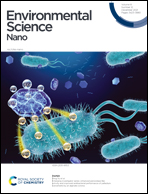Amino-modified zirconia aerogels for the efficient filtration of NO2: effects of water on the removal mechanisms†
Abstract
An amino-modified zirconia aerogel (AMZA) was prepared using a facile post-synthesis grafting strategy by introducing 3-aminopropyltriethoxysilane (APTES) into the zirconia sol–gel process and ambient pressure drying (APD). The AMZA shows a three-dimensional mesoporous network assembled by numerous sheet-like aggregates with polymolecular polysiloxane layers covering the surface. The AMZA has a density comparable to that of ASZM–TEDA impregnated activated carbon, which is approximately 65% less than that of porous zirconium hydroxide. NO2 breakthrough tests show that the AMZA has excellent NO2 filtration ability at different relative humidity (RH) levels, with a breakthrough time as long as 362 min and limited NO by-product evolution (≤8%). In particular, under high humidity conditions, the AMZA's adsorption performance against NO2 is significantly superior to that of ASZM–TEDA carbon and porous zirconium hydroxide. Through meticulous post-breakthrough characterization, the impact of water molecules on the NO2 adsorption mechanism was systematically investigated. At low RH, NO2 and NO are mainly removed through redox reactions, with nitramine and nitrosamine compounds serving as the principal adsorption products. At high RH, NO2 is mainly converted to HNO3 by hydrolysis, which is then mitigated through acid–base neutralization to form nitrate species. When water molecules are pre-adsorbed on the AMZA surface, NO2 elimination can be controlled by diffusion, and the aforementioned adsorption products show a similar formation trend.


 Please wait while we load your content...
Please wait while we load your content...